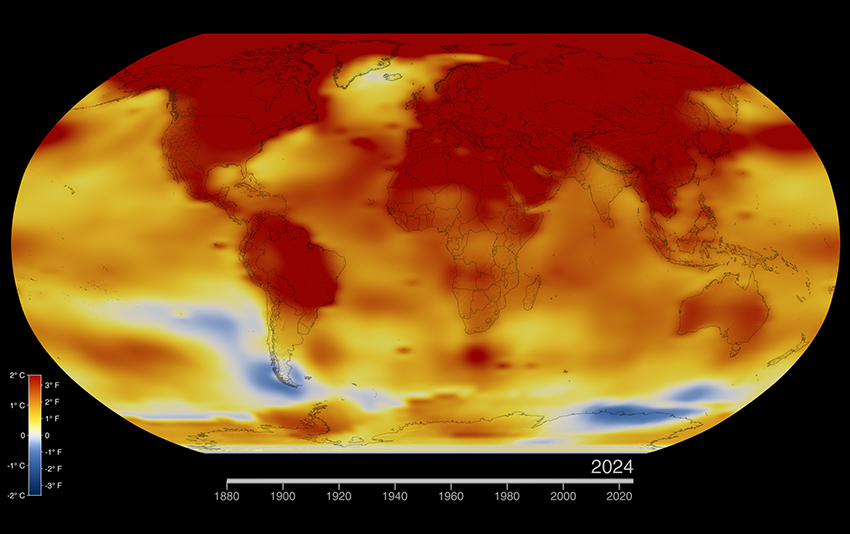Is Earth Warming Faster Than Before?
Record-breaking temperatures were observed in 2023 and 2024. Does this reflect an acceleration in the rate of Earth’s warming?

18 November 2025
|

8 minutes
|
The “hockey stick” graph, first published in 1998, is perhaps the most famous and influential visualization of Earth’s warming in recent decades. According to the graph—so named because its shape resembles a hockey stick—the average temperature in the Northern Hemisphere remained relatively stable from the year 1000 until about 1900. Around 1900, however, temperatures began to rise sharply.
The graph has been updated several times since, and we now know that global temperatures have continued to increase well beyond 1998, when it was first published. Until recently, scientists generally estimated that human-driven global warming caused by greenhouse gas emissions was occurring at a relatively steady rate. But the extreme records set in 2023 and 2024 for annual average temperatures – far beyond what the scientific community had anticipated – raise an important question: Has the rate of warming increased in recent years?
A group of researchers turned to the oceans in search of an answer and found alarming evidence: the rate of ocean warming has more than tripled in recent decades.

The map shows how much each region differs from the 1951–1980 average temperature. Orange/red indicates above-average temperatures, blue indicates below-average temperatures, and white indicates average temperatures. Global surface temperature in 2024 | NASA’s Scientific Visualization Studio.
Why Measure Warming in the Ocean?
To understand why the ocean is the best place to measure Earth’s warming rate, we must recall how human activity influences the planet’s temperature. Since the Industrial Revolution, humanity has emitted increasing amounts of greenhouse gases into the atmosphere, amplifying the greenhouse effect. The result of this enhanced greenhouse effect is that more energy becomes trapped in the atmosphere, leading to the warming of the planet.
We usually think of this warming in terms of temperature — for example, the global warming target is defined as limiting temperature increase to less than two degrees, and Earth’s warming to date is also expressed in degrees. But a change in temperature is actually a reflection of a shift in Earth’s overall energy balance.
Today, Earth contains more thermal energy (heat) than it did one or two hundred years ago, and most of this excess energy is stored in the oceans. In absolute terms, the changes in ocean temperature are not dramatically different from those in atmospheric temperature. However, because the ocean’s heat capacity is far greater — both due to its enormous mass and because water has a high specific heat – the amount of energy associated with ocean warming is vastly larger than the energy associated with atmospheric warming. It is estimated that the oceans have absorbed about 90% of the excess energy produced by the enhanced greenhouse effect, making the rate of ocean temperature change a strong indicator of the planet’s overall warming rate.
Recent studies show that this ocean warming rate – and therefore the overall warming rate — has risen sharply in recent decades. Using satellite observations and statistical analysis of long-term heating trends, a group of researchers from England found that the ocean warming rate between 1985–1989 was 0.06°C per decade, but between 2019–2023 it rose to 0.27°C per decade. They concluded that the current warming rate is about 3.5 times higher than it was forty years ago. According to their analysis, the period between April 2023 and July 2024 – during which the average ocean temperature was about 0.18°C above normal – contributed significantly to the high warming rate observed in recent years
The question is why ocean temperatures were so elevated during this period, and whether this reflects a true acceleration in Earth’s overall warming.

During an El Niño year, the upwelling of cold water from the depths of the Pacific Ocean into its upper layers weakens, causing the ocean surface to warm - and with it, the atmosphere. Three-dimensional representation of the 1997 El Niño phenomenon | European Space Agency, Wikimedia.
The Factors Behind the Temperature Increase
Until now, the two main factors thought to drive Earth’s record-breaking temperature rise were the strengthening greenhouse effect caused by human emissions and the El Niño cycle. But can these two factors fully explain the exceptional temperatures of 2023 and 2024?
To answer this, it’s helpful to recall what El Niño is. El Niño is a climate pattern that alters global temperature distribution, especially in and around the Pacific Ocean. During El Niño years, the upwelling of cold deep water in the Pacific weakens, warming the ocean surface and, in turn, the atmosphere.
However, El Niño can provide only a partial explanation for the ocean’s recent temperature records. Although 2023 was an El Niño year — almost certainly contributing to elevated ocean temperatures — the most extreme heat anomalies occurred mainly in the Atlantic Ocean and the Mediterranean Sea, regions not influenced by El Niño. Significant warming was also recorded in the Southern Ocean, which is only weakly affected compared to the Pacific. Moreover, by mid-2024 the El Niño cycle had shifted to a neutral phase, meaning 2024 was not considered an El Niño year; yet Earth’s overall temperature — and especially ocean temperatures — was higher in 2024 than in 2023, despite 2023 being an El Niño year.

Sulfur particles emitted by ship engines once promoted the formation of brighter, more reflective clouds above major shipping lanes, increasing the amount of sunlight reflected back into space. Clouds above shipping routes in the North Pacific Ocean | NASA/GSFC/Jeff Schmaltz/MODIS Land Rapid Response Team.
Because El Niño alone does not account for the extraordinary temperatures of 2023 and 2024, scientists suspect that Earth’s warming may be accelerating. But what exactly does this acceleration mean, and what might be causing it? As with many questions at the frontier of climate science, the answers at this stage remain uncertain and somewhat speculative.
According to one theory that has received considerable attention, the excess ocean warming of recent years may be linked to changes in the fuels used by ships. New regulations prompted a transition to cleaner fuels, causing ships to emit far less sulfur — a pollutant harmful to human health. However, the reduction in sulfur emissions has an unintended climate effect: sulfur particles from ship exhaust previously contributed to the formation of clouds above major shipping lanes, and these clouds reflected some incoming sunlight back into space. Recent studies indicate that the shift to cleaner fuels is reducing this ship-induced cloud cover above the oceans, causing the oceans to absorb more solar radiation and warm further.
Is this effect alone enough to explain the recent acceleration in global warming? It remains too early to know for sure. Research groups around the world are actively investigating this question. Only with additional data in the coming years will we be able to tell whether the warming rate will continue to climb — indicating a true acceleration — or eventually return to its previously observed pace.





